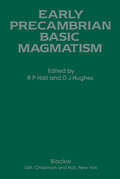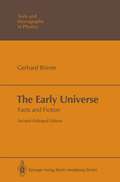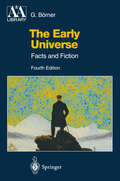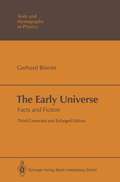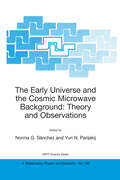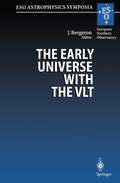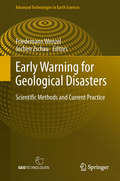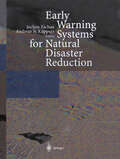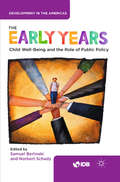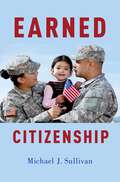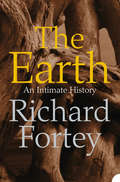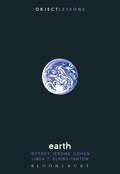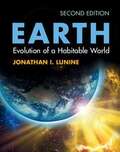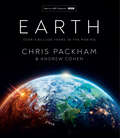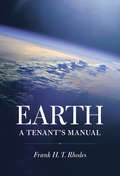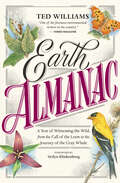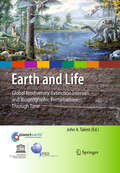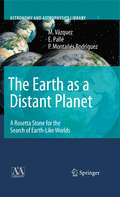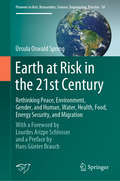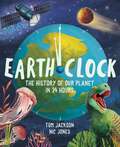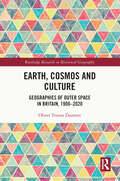- Table View
- List View
Early Precambrian Basic Magmatism
by R.P. Hall D.J. HughesBasic magmatic rocks make up approximately three-quarters of the crust ofthe present day Earth. Because we can observe and study the volcanic products of present day tectonic regimes comprehensively, we can shed light on ancient tectono-magmatic provinces, and thereby deduce the petrogenesis and evolution of the oldest basic rocks. This is the primary objective of this book. The book was conceived in order to provide a comprehensive review of the basic rocks produced during the first half of the Precambrian, i.e. the Archaean and early Proterozoic, to about 1.8 Ga years ago. Two major questions are addressed. First, what basic magmas were generated during the early Precambrian: were these magmas globally uniform, and to what extent were prevailing tectonic controls and compo sitions analogous to those of the present day? Clearly, this can be answered only by bringing together fundamental information about all relevant basic magmatic events. Second, is there any systematic temporal variation in the nature of basic suites, and what implications might such variations have on our interpretations of early Earth history? Are there important differences between early Archaean, late Archaean, Proterozoic and modern basic magmatic suites? The book uses two approaches to address these questions. Early chapters examine the fundamental characteristics of these basic rocks, whilst later chapters assess regional distribution and development by providing an overview of each major early Precambrian craton.
The Early Universe: Facts and Fiction (Theoretical and Mathematical Physics)
by Gerhard BörnerConnections developed in recent years between particle physics and cosmologyare the focus of attention in this new textbook. The author describes some of the theories which have been developed to describe the fundamental interaction of elementary particles in the extremely high temperatures of the early universe, taking care to distinguish facts and well-established results from hypotheses and speculations. - The three parts of the book discuss the standard hot big bang model of the earlyuniverse, the basic ideas of the standard and the grand unified theories of elementary particles, and the influence of dark matter on the large-scale evolution of structure. In addition to making some minorcorrections the author has added an appendix presenting new results and an updated bibliography. Two main groups of readers are addressed: research students in astronomy can use this book to understand the impact of elementary particle theory on cosmology, while research students in particle physics can use it to acquaint themselves with the basic facts of cosmology. The book is written carefully enough to appeal also to a wider audience of physicists.
The Early Universe: Facts and Fiction (Astronomy and Astrophysics Library)
by Gerhard BörnerThis fourth edition of Börner's "The Early Universe" is practically a new book, not just updated version. In particular, it is now organized so as to make it more useful as a textbook. And problem sections are also added. In the centre are the connections between particle physics and cosmology: The standard model, some basic implications of quantum field theory and the questions of structure formation. Special emphasis is given to the observed anisotropies of the cosmic microwave background and the consequences drawn for cosmology and for the structure formation models. Nuclear and particle physicists and astrophysicists, researchers and teachers as well as graduate students will welcome this new edition of a classic text and reference.
The Early Universe: Facts and Fiction (Theoretical and Mathematical Physics)
by Gerhard BörnerIn this corrected and enlarged edition of Börner's well respected textbook, you will find an up-to-date account of the interplay between particle physics and astrophysics upon which modern cosmology is founded. The author describes some of the theories which have been developed to model the fundamental interaction of elementary particles in the extremely high temperatures of the early universe, taking care to distinguish facts and well- established results from hypotheses and speculations. The three parts of the book discuss the standard hot big bang model of the early universe, the basic ideas of the standard and the grand unified theories of elementary particles, and the influence of dark matter of the large- scale evolution of structure. In addition to making some minor corrections, the author has added an appendix presenting new results and an updated bibliography. Two main groups of readers are addressed: research students in astronomy can use this book to understand the impact of elementary particle theory on cosmology, while research students in particle physics can use it to acquaint themselves with the basic facts of cosmology. The book is written carefully enough to appeal also to a wider audience of physicists.
The Early Universe and the Cosmic Microwave Background: Theory and Observations (NATO Science Series II: Mathematics, Physics and Chemistry #130)
by Norma G. Sànchez Yuri N. ParijskijThe goal of the Daniel Chalonge School on Astrofundamental Physics is to contribute to a theory of the universe (and particularly of the early universe) up to the marks, and at the scientific height of, the unprecedented accuracy, existent and expected, in the observational data. The impressive development of modern cosmology during the last decades is to a large extent due to its unification with elementary particle physics and quantum field theory. The cross-section between these fields has been increasing setting up Astrofundamental Physics. The early universe is an exceptional (theoretical and experimental) laboratory in this new discipline. This NATO Advanced Study Institute provided an up dated understanding, from a fundamental physics and deep point of view, of the progress and key issues in the early universe and the cosmic microwave background: theory and observations. The genuine interplay with large scale structure formation and dark matter problem were discussed. The central focus was placed on the cosmic microwave background. Emphasis was given to the precise inter-relation between fundamental physics and cosmology in these problems, both at the theoretical and experimental/observational levels, within a deep and well defined programme which provided in addition, a careful interdisciplinarity. Special sessions were devoted to high energy cosmic rays, neutrinos in astrophysics, and high energy astrophysics. Deep understanding, clarification, synthesis, careful interdisciplinarity within a fundamental physics framework, were the main goals of the course.
The Early Universe with the VLT: Proceedings of the ESO Workshop Held at Garching, Germany, 1–4 April 1996 (ESO Astrophysics Symposia)
by Jacqueline BergeronThis is the second ESO workshop in aseries dedicated to science oppor tunities with the VLT. At the first workshop all areas of astronomical research were discussed. This second workshop is dedicated to research projects on the early Universe and has provided a forum for discussing strategies for studying faint distant objects in the optical and infrared spectral regions. This field is evolving very rapidly. There are several new surveys of galax ies and clusters of galaxies at intermediate redshift and quasars at very high redshift. Major advances in the morphological studies of distant galaxies, surveys of galaxies at high redshift and searches for primeval galaxies have been rendered possible by the new facilities provided by the Rubble Space Telescope and the Keck Telescope. Observational constraints on the evolution and formation of galaxies and large-scale structures as well as the cosmic chemical evolution were criti cally discussed with regard to theory and numerical simulations. In this context, the VLT first generation instrument capabilities were presented comprehensively and their use as cosmological tools discussed . The concluding remarks of the workshop focussed on the analysis of var ious possibilities for the VLT second generation instrumentation. Many of these topics were covered by invited reviews and talks, as well as some contributed talks. They are included in this volume together with the poster papers.
Early Warning for Geological Disasters: Scientific Methods and Current Practice (Advanced Technologies in Earth Sciences)
by Friedemann Wenzel Jochen ZschauThe past years have seen new technologies that could be utilized for early warning and real-time loss estimation. They include self-organizing sensor networks, new satellite imagery with high resolution, multi-sensor observational capacities, and crowd sourcing. From this and improved physical models, data processing and communication methodologies a significant step towards better early warning technologies has been achieved by research.At the same time, early warning systems became part of the disaster management practice for instance in Japan and Indonesia. This book marks the important point where:Research activities continue to improve early warning Experience with applications is expandingAt this critical point in development of early warning for geological disasters it is timely to provide a volume that documents the state-of-the-art, provides an overview on recent developments and serves as knowledge resource for researcher and practitioners.
Early Warning Systems for Natural Disaster Reduction
by Jochen Zschau Andreas N. KüppersWritten for a broad audience this book offers a comprehensive account of early warning systems for hydro meteorological disasters such as floods and storms, and for geological disasters such as earthquakes. One major theme is the increasingly important role in early warning systems played by the rapidly evolving fields of space and information technology. The authors, all experts in their respective fields, offer a comprehensive and in-depth insight into the current and future perspectives for early warning systems. The text is aimed at decision-makers in the political arena, scientists, engineers and those responsible for public communication and dissemination of warnings.
The Early Years: Child Well-Being and the Role of Public Policy
by Inter-American Development Bank Norbert SchadyThis book is open access under a CC BY-NC-ND 3.0 IGO license. The Early Years analyzes the development of Latin American and Caribbean children and makes a compelling case for government intervention in what is instinctively a family affair. Spending on effective programs for young children is an investment that, if done well, will have very high returns, while failure to implement such programs will lower the returns on the hefty investments being made in primary, secondary, and higher education. Policies for young children belong at the core of a country's development agenda, alongside policies to develop infrastructure and strengthen institutions. However, if the services provided (or funded) by governments are to benefit children, they must be substantially better than what is currently being delivered in the region. This book offers suggestions for improving public policy in this critical area.
Earned Citizenship
by Michael J. SullivanThe migration and settlement of 11 million unauthorized immigrants is among the leading political challenges facing the United States today. The majority of unauthorized immigrants in the U.S. have been here for more than five years, and are settling into American communities, working, forming families, and serving in the military, even though they may be detained and deported if they are discovered. An open question remains as to what to do about unauthorized immigrants who are already living in the United States. On one hand it is important that the government sends a message that future violations of immigration law will not be tolerated. On the other sits a deeper ethical dilemma that is the focus of this book: what do the state and citizens owe to unauthorized immigrants who have served their adopted country? Earned Citizenship argues that long-term unauthorized immigrant residents should be able to earn legalization and a pathway to citizenship through service in their adopted communities. Their service would act as restitution for immigration law violations. Military service in particular would merit naturalization in countries with a strong citizen-soldier tradition, including the United States. The book also considers the civic value of caregiving as a service to citizens and the country, contending that family immigration policies should be expanded to recognize the importance of caregiving duties for dependents. This argument is part of a broader project in political theory and public policy aimed at reconciling civic republicanism with a feminist ethic of care, and its emphasis on dependency work. As a whole, Earned Citizenship provides a non-humanitarian justification for legalizing unauthorized immigrants based on their contributions to citizens and institutions in their adopted nation.
Earned Citizenship
by Michael J. SullivanThe migration and settlement of 11 million unauthorized immigrants is among the leading political challenges facing the United States today. The majority of unauthorized immigrants in the U.S. have been here for more than five years, and are settling into American communities, working, forming families, and serving in the military, even though they may be detained and deported if they are discovered. An open question remains as to what to do about unauthorized immigrants who are already living in the United States. On one hand it is important that the government sends a message that future violations of immigration law will not be tolerated. On the other sits a deeper ethical dilemma that is the focus of this book: what do the state and citizens owe to unauthorized immigrants who have served their adopted country? Earned Citizenship argues that long-term unauthorized immigrant residents should be able to earn legalization and a pathway to citizenship through service in their adopted communities. Their service would act as restitution for immigration law violations. Military service in particular would merit naturalization in countries with a strong citizen-soldier tradition, including the United States. The book also considers the civic value of caregiving as a service to citizens and the country, contending that family immigration policies should be expanded to recognize the importance of caregiving duties for dependents. This argument is part of a broader project in political theory and public policy aimed at reconciling civic republicanism with a feminist ethic of care, and its emphasis on dependency work. As a whole, Earned Citizenship provides a non-humanitarian justification for legalizing unauthorized immigrants based on their contributions to citizens and institutions in their adopted nation.
The Earth: An Intimate History
by Richard ForteyThis ebook edition does not include illustrations. ‘The Earth is a true delight: full of awe-inspiring details… it blends travel, history, reportage and science to creat an unforgettable picture of our ancient earth.’ Sunday Times
Earth (Object Lessons)
by Linda T. Elkins-Tanton Jeffrey Jerome CohenObject Lessons is a series of short, beautifully designed books about the hidden lives of ordinary things.In Earth, a planetary scientist and a literary humanist explore what happens when we think of the Earth as an object viewable from space. As a "blue marble,†? "a blue pale dot,†? or, as Chaucer described it, "this litel spot of erthe,†? the solitary orb is a challenge to scale and to human self-importance. Beautiful and self-contained, the Earth turns out to be far less knowable than it at first appears: its vast interior an inferno of incandescent and yet solid rock and a reservoir of water vaster than the ocean, a world within the world. Viewing the Earth from space invites a dive into the abyss of scale: how can humans apprehend the distances, the temperatures, and the time scale on which planets are born, evolve, and die?Object Lessons is published in partnership with an essay series in The Atlantic.
Earth (Object Lessons)
by Linda T. Elkins-Tanton Jeffrey Jerome CohenObject Lessons is a series of short, beautifully designed books about the hidden lives of ordinary things.In Earth, a planetary scientist and a literary humanist explore what happens when we think of the Earth as an object viewable from space. As a “blue marble,” “a blue pale dot,” or, as Chaucer described it, “this litel spot of erthe,” the solitary orb is a challenge to scale and to human self-importance. Beautiful and self-contained, the Earth turns out to be far less knowable than it at first appears: its vast interior an inferno of incandescent and yet solid rock and a reservoir of water vaster than the ocean, a world within the world. Viewing the Earth from space invites a dive into the abyss of scale: how can humans apprehend the distances, the temperatures, and the time scale on which planets are born, evolve, and die?Object Lessons is published in partnership with an essay series in The Atlantic.
Earth: Evolution Of A Habitable World
by Jonathan I. LunineFully updated throughout, including revised illustrations and new images from NASA missions, this new edition provides an overview of Earth's history from a planetary science perspective for Earth science undergraduates. Earth's evolution is described in the context of what we know about other planets and the cosmos at large, from the origin of the cosmos to the processes that shape planetary environments and from the origins of life to the inner workings of cells. Astronomy, Earth science, planetary science and astrobiology are integrated to give students the whole picture of how the Earth has come to its present state and an understanding of the relationship between key ideas in different fields. The book presents concepts in nontechnical language and mathematical treatments are avoided where possible. New end-of-chapter summaries and questions allow students to check their understanding and critical thinking is emphasized to encourage students to explore ideas scientifically for themselves.
Earth: Over 4 Billion Years In The Making
by Chris Packham Andrew Cohen‘Combines the natural history of programmes such as David Attenborough’s Planet Earth with the planetary focus of Brian Cox’s Universe’ Guardian A beautiful, full colour book to accompany the 5 part BBC TV series telling the most important story of all, the deep history of our own planet.
Earth: A Tenant's Manual
by Frank H. Rhodes"It's impossible to grasp the whole planet or integrate all the descriptions of it. But because we live here, we have to try. This is not just an artistic compulsion or an existential yearning, still less an academic exercise. It's a survival issue. This is the only planet we have. We're stuck here, and we don't own the place—it would be the height of arrogance to assume that we do. We're tenants here, not owners, but we're tenants with hope for a long-term tenancy. We want to extend our lease just as far as we can."—from Earth: A Tenant's ManualIn Earth: A Tenant's Manual, the distinguished geologist Frank H. T. Rhodes, President Emeritus of Cornell University, provides a sweeping, accessible, and deeply informed guide to the home we all share, showing us how we might best preserve the Earth's livability for ourselves and future generations. Rhodes begins by setting the scene for our active planet and explaining how its location and composition determine how the Earth works and why it teems with life. He emphasizes the changes that are of concern to us today, from earthquakes to climate change and the clashes over the energy resources needed for the Earth's exploding population. He concludes with an extended exploration of humanity's prospects on a complex, protean, and ultimately finite world. It is not a question of whether the planet is sustainable; the challenge facing life on Earth—and the life of the Earth—is whether an expanding and high-consumption species like ours is sustainable. Only new resources, new priorities, new policies and, most of all, new knowledge, can reverse the damage that humanity is doing to our home—and ourselves. A sustainable human future, Rhodes concludes in this eloquent, sobering, but ultimately optimistic book, will require a sense of responsible stewardship, for we are not owners of this planet; we are tenants.Surveying the systems, large and small, that govern Earth's processes and influence its changes, Rhodes addresses the negative consequences of human activities for the health of its regulatory systems but offers practical suggestions as to how we might effect repairs, or at least limit further damage to our home.
Earth 2020: An Insider's Guide To A Rapidly Changing Planet
by Philippe TortellFifty years have passed since the first Earth Day, on 22 April 1970. This accessible, incisive and timely collection of essays brings together a diverse set of expert voices to examine how the Earth’s environment has changed over this past half century, and what lies in store for our planet over the coming fifty years. <p><p> Earth 2020: An Insider’s Guide to a Rapidly Changing Planet responds to a public increasingly concerned about the deterioration of Earth’s natural systems, offering readers a wealth of perspectives on our shared ecological past, and on the future trajectory of planet Earth. <p> Written by world-leading thinkers on the front-lines of global change research and policy, this multi-disciplinary collection maintains a dual focus: some essays investigate specific facets of the physical Earth system, while others explore the social, legal and political dimensions shaping the human environmental footprint. In doing so, the essays collectively highlight the urgent need for collaboration across diverse domains of expertise in addressing one of the most significant challenges facing us today. <p> Earth 2020 is essential reading for everyone seeking a deeper understanding of the past, present and future of our planet, and the role of humanity in shaping this trajectory.
Earth 2020: An Insider’s Guide to a Rapidly Changing Planet
by Philippe TortellFifty years have passed since the first Earth Day, on 22 April 1970. This accessible, incisive, and timely collection of essays brings together a diverse set of expert voices to examine how the Earth’s environment has changed over this past half century, and what lies in store for our planet over the coming fifty years. Earth 2020: An Insider’s Guide to a Rapidly Changing Planet responds to a public increasingly concerned about the deterioration of Earth’s natural systems, offering readers a wealth of perspectives on our shared ecological past, and on the future trajectory of planet Earth. Written by world-leading thinkers on the front-lines of global change research and policy, this multi-disciplinary collection maintains a dual focus: some essays investigate specific facets of the physical Earth system, while others explore the social, legal and political dimensions shaping the human environmental footprint. In doing so, the essays collectively highlight the urgent need for collaboration across diverse domains of expertise in addressing one of the most significant challenges facing us today. Earth 2020 is essential reading for everyone seeking a deeper understanding of the past, present and future of our planet, and the role of humanity in shaping this trajectory.
Earth Almanac: A Year of Witnessing the Wild, from the Call of the Loon to the Journey of the Gray Whale
by Ted WilliamsRenowned nature writer Ted Williams captures the wonders of the natural world in this series of short observational essays that describe the fleeting beauty of each season, from the deliberate flight of a bumblebee to the lush fragrance of wild grapes.
Earth and Life: Global Biodiversity, Extinction Intervals and Biogeographic Perturbations Through Time (International Year of Planet Earth)
by John A. TalentThis volume focuses on the broad pattern of increasing biodiversity through time, and recurrent events of minor and major ecosphere reorganization. Intense scrutiny is devoted to the pattern of physical (including isotopic), sedimentary and biotic circumstances through the time intervals during which life crises occurred. These events affected terrestrial, lacustrine and estuarine ecosystems, locally and globally, but have affected continental shelf ecosystems and even deep ocean ecosystems. The pattern of these events is the backdrop against which modelling the pattern of future environmental change needs to be evaluated.
The Earth as a Distant Planet: A Rosetta Stone for the Search of Earth-Like Worlds (Astronomy and Astrophysics Library)
by M. Vázquez E. Pallé P. Montañés RodríguezIn The Earth as a Distant Planet, the authors become external observers of our solar system from a distance and try to determine how one can understand how Earth, the third in distance to the central star, is essentially unique and capable of sustaining life. The knowledge gained from this original perspective is then applied to the search for other planets outside the solar system, or exoplanets. Since the discovery in 1992 of the first exoplanet, the number of planet detections has increased exponentially and ambitious missions are already being planned for the future. The exploration of Earth and the rest of the rocky planets are Rosetta stones in classifying and understanding the multiplicity of planetary systems that exist in our galaxy. In time, statistics on the formation and evolution of exoplanets will be available and will provide vital information for solving some of the unanswered questions about the formation, as well as evolution of our own world and solar system. Special attention is paid to the biosignatures (signs of life) detectable in the Earth's reflected spectra and the search for life in the universe. The authors are experts on the subject of extrasolar planets. They provide an introductory but also very much up-to-date text, making this book suitable for researchers and for advanced students in astronomy and astrophysics.
Earth at Risk in the 21st Century: With a Foreword by Lourdes Arizpe Schlosser and a Preface by Hans Günter Brauch (Pioneers in Arts, Humanities, Science, Engineering, Practice #18)
by Úrsula Oswald SpringEarth at Risk in the 21st Century offers critical interdisciplinary reflections on peace, security, gender relations, migration and the environment, all of which are threatened by climate change, with women and children affected most. Deep-rooted gender discrimination is also a result of the destructive exploitation of natural resources and the pollution of soils, water, biota and air. In the Anthropocene, the management of human society and global resources has become unsustainable and has created multiple conflicts by increasing survival threats primarily for poor people in the Global South. Alternative approaches to peace and security, focusing from bottom-up on an engendered peace with sustainability, may help society and the environment to be managed in the highly fragile natural conditions of a ‘hothouse Earth’. Thus, the book explores systemic alternatives based on indigenous wisdom, gift economy and the economy of solidarity, in which an alternative cosmovision fosters mutual care between humankind and nature.• Special analysis of risks to the survival of humankind in the 21st century.• Interdisciplinary studies on peace, security, gender and environment related to global environmental and climate change.• Critical reflections on gender relations, peace, security, migration and the environment• Systematic analysis of food, water, health, energy security and its nexus.• Alternative proposals from the Global South with indigenous wisdom for saving Mother Earth.
Earth Clock: The History of Our Planet in 24 Hours
by Tom JacksonThe entire history of Planet Earth as you've never seen it before, ideal for readers 8+.Our planet has been spinning in the blackness of Space for 4.5 billion years. People have only been around for a tiny part of it. But what happened before we arrived on the scene? Before animals, dinosaurs and even trees? Imagine if we could discover Earth's history in one day...Starting the clock from the formation of the Earth, discover each significant moment in time on the clock, counting down to midnight. Earth Clock covers the most interesting and high-impact moments of our planet's geological history with stunning, detailed illustrations, while charting the evolution of life on Earth, from ancient single-celled organisms to the species we know today, until modern humans appear – at just four seconds to midnight. What will tomorrow bring?
Earth, Cosmos and Culture: Geographies of Outer Space in Britain, 1900–2020 (Routledge Research in Historical Geography)
by Oliver Tristan DunnettThis book traces the development of diverse British cultures of outer space, utilizing key geographical concepts such as landscape, place, and national identity. It examines the early visionary ideas of writers H. G. Wells and Olaf Stapledon, the ambitious British space programme of the 1960s, and narrations of British cultural identity that accompanied the space missions of Helen Sharman, Beagle 2 and Tim Peake. The exploration of British cultures of outer space throughout the book helps understand the emergence of the British Interplanetary Society. It also explains its significance in pre-war and post-war periods through an analysis of the roles of influential figures such as Arthur C. Clarke and Patrick Moore. The chapters explore utopian and dystopian representations of space exploration, examine the mysterious phenomenon of UFO culture, and consider plans for humanity’s imagined future across interstellar space. Throughout the book geography is advocated as a home for critical studies of outer space, illuminating its significance in terms of the reciprocal relationships between exploration and the sublime, science and the imagination, Earth and cosmos. As an emergent field of research in the social sciences, this book makes an excellent contribution to the study of the outer space in Britain and abroad developing a distinctive kind of outer spatial geography with major implications for future teaching and research.
